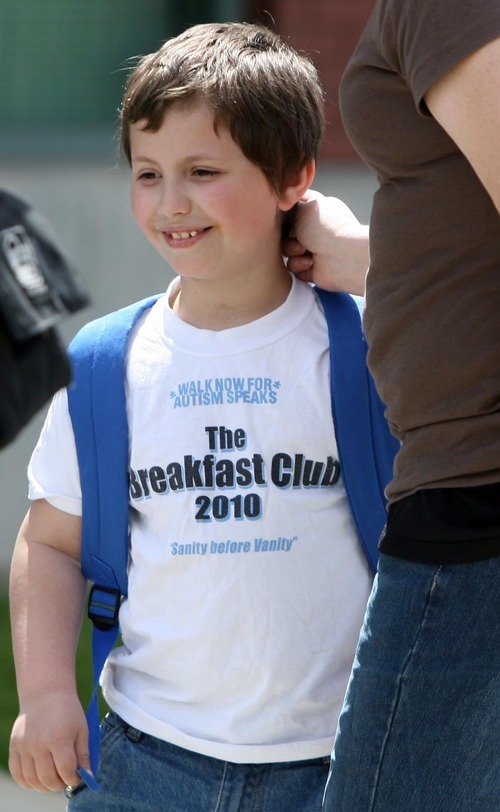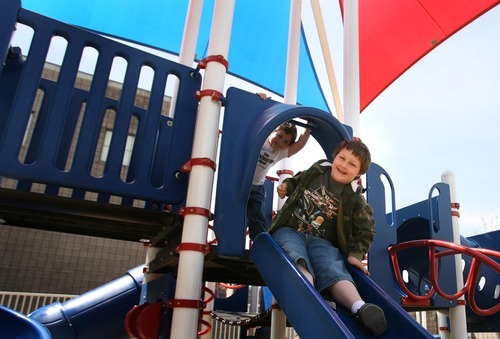This is an archived article that was published on sltrib.com in 2011, and information in the article may be outdated. It is provided only for personal research purposes and may not be reprinted.
When her son was 22 months old, Laura Anderson said goodbye to a walking, talking, smiling boy and entered the silent world of autism.
Over a six-week period, the Ty she knew disappeared and a new toddler appeared, one that stopped smiling and saying "Mama."
Numbers released Friday show that's a reality for more Utah parents: The number of children with the neurobehavioral disorder doubled from 2002 to 2008.
About two children per day were born with an autism spectrum disorder in 2008. Put another way, 1 in 77 8-year-olds had the disorder that year — double from six years before.
"It is our life," said Anderson, vice president of the parent-run Autism Council of Utah, at a news conference announcing the most recent autism prevalence numbers. "If you think autism isn't going to touch you somehow in your life, you are sadly mistaken. It's in our communities. It's in our schools. It will be in our workplaces."
The disorder, which can cause mild to severe disabilities, is marked by difficulties communicating and interacting socially. Children with autism often also engage in repetitive behavior. Many suffer from sleep disorders, anxiety, depression and other medical problems.
The study was funded by the Utah Registry of Autism and Developmental Disabilities and published online in the peer-reviewed journal Autism and Developmental Disorders. Researchers determined the prevalence by looking at the number of children ages 4, 6 and 8 in Davis, Salt Lake and Utah counties who had been diagnosed with an autism spectrum disorder or who received special education services for autism.
Boys were more likely than girls to be diagnosed: 1 in 49 8-year-old boys had the disorder in 2008.
The prevalence was lower among younger children, which researchers suggested meant children are still being diagnosed late. Doctors want children to be identified by age 2 because earlier intervention — including behavioral, speech and occupational therapies — helps them become more independent.
"After all this work we still don't know what the true prevalence of autism is in Utah," said Judith Pinborough-Zimmerman, the study's lead author and research assistant professor in the University of Utah's Department of Psychiatry. "We are only capturing kids that have a previous diagnosis. There may be many children and adults who have autism and still haven't been diagnosed."
Utah's rate appears to be higher than the national average: The latest national figures are from 2006 and show the rate among 8-year-olds was 1 in 111. The national figures are expected to be updated by the summer.
It's unclear why Utah's numbers have doubled: A change in the diagnostic criteria, increased awareness and better diagnostic tools may have contributed to the rise.
But that doesn't fully explain the increase, said Jocelyn Taylor, one of the study authors and an autism education specialist at the Utah State Office of Education.
"As I interview teachers, I have veterans, teachers who have been teaching 20 or 30 years who say they've never seen anything quite like this," Taylor said. "While there may be better recognition of autism, there seems to be more autism."
Normally, the prevalence of developmental disabilities plateaus after five years, she said. But the number of children with autism has continued to grow for the past 15 years, she said.
Researchers don't know all of the causes of autism spectrum disorders, though they believe genetic and environmental factors — from infections to toxins — play a role.
Some are looking at pollution as a possible culprit. A study published last year in Environmental Health Perspectives found that women living near freeways during pregnancy and near the time of delivery were at greater risk of having a child with autism.
"The thinking now is that the risk of having a child with autism occurs before the child is born. The first three months of pregnancy is crucial," Pinborough-Zimmerman said.
"My hope is that through these types of research we can learn what the risk factors are and the causes of autism and that we possibly could prevent autism."
Carmen Pingree, for whom Salt Lake City's Center for Children with Autism is named, said the numbers should justify more funding for research on possible causes, as well as money to boost services for those with autism and their families.
"We've got to get to the bottom of what is causing this," she said. "This is not stopping and we need to understand better how we can best embrace these families and support the individuals who are dealing with this life-long problem."
Taylor, with the state office of education, said children with autism make up 4 percent of students in special education in Utah — far less than the 20 percent who have communication disorders.
Still, the public education system is overwhelmed.
"We have children coming into the system, more children than we've ever seen before," Taylor said. "It's all ages and it's along the entire spectrum [of the disorder], it's not just severe or moderate or gifted.
"I don't know if we can ever be ready for these kinds of numbers. It really has taken us by storm."
Anderson's son, Ty, is now 14 years old. He still doesn't talk and cannot dress himself or prepare his own meals. He may always need 24-hour care.
"I hope he has the ability to live the life of his dreams, whatever his dreams are," she said. "Ideally, I would love for him to be someplace where he's safe, someplace where's he's valued, someplace where he's nurtured and he's given opportunities.
"I don't know what that looks like yet."





